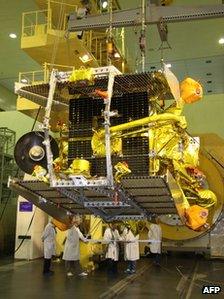Signal picked up from Russia's stranded Mars probe
- Published

Phobos-Grunt is Russia's most ambitious space venture in years
Contact has finally been made with Russia's troubled Mars mission, says the European Space Agency (Esa).
The agency reports that its tracking station in Perth, Australia, picked up a signal from the Phobos-Grunt probe.
Esa is now working with Russian engineers to see how best to maintain communications with the craft.
Phobos-Grunt has been stuck in Earth orbit since its launch on 9 November, unable to fire the engine that would take it on to Mars.
It raises the hope that Russian controllers can establish what is wrong with the spacecraft and fix it.
Phobos-Grunt still has a short window in which to start its journey before a change in the alignment of the planets makes the distance to the Red Planet too big to cross.
Low power
The European Space Operations Centre (Esoc) in Darmstadt, Germany, reports that the contact was made at 2025 GMT on Tuesday.
The agency had to modify its 15m dish in Perth to get through to Phobos-Grunt. This required widening the antenna's beam to catch the probe in its uncertain orbit.
Perth also reduced the power of the transmission to make it more like the sort of faint X-band signal the craft would expect to hear at Mars.
"We were able to get our transmission in and the commands that were sent then allowed the transmitter on the spacecraft to be turned on; and then we saw the signal coming back into our big dish," explained Dr Klaus-Juergen Schulz, the head of the ground station systems division at Esa-Esoc.
"We also made some radiometric measurements to derive a more precise orbit. This should make it easier to contact Phobos-Grunt in future."
The next pass opportunity is after 2020 [GMT]. At that time, the probe will be in sight of the dish and its solar panels will also be flooded with sunlight to power onboard systems.
All the information gathered in Tuesday night's communication, including telemetry from Phobos-Grunt, has been passed straight to the Russians.
Exciting prospect
The probe was built to land on the larger of Mars' two moons, Phobos, and scoop up rock to bring back to Earth.
Such a venture should yield fascinating new insights into the origin of the 27km-wide object and the planet it circles.
The mission is also notable because China's first Mars satellite, Yinghuo-1, has been launched piggy-back on the main Russian spacecraft.
The 13-tonne mission was initially lifted into a 350km-high orbit above Earth, with the expectation that the probe's big engine would fire twice - first, to raise that orbit, and, second, to set course for Mars.
But for some reason, those engine burns never happened, and Phobos-Grunt has continued to circle the Earth. All efforts to talk with it have failed - until now.
Fortunately, the probe has managed to maintain itself in a stable condition. The perigee of its elliptical orbit (the closest point it comes to Earth) has actually risen slightly, and is just above 200km.
If engineers can keep a communication line open to the craft, they can begin to diagnose its problems.
The best scenario is that the issues are related to a software anomaly, and that engineers can then upload new commands.
But if the fault lies in a hardware malfunction, Phobos-Grunt may still be beyond hope.
Mars probe veers off course
- Published22 November 2011
- Published21 November 2011
- Published10 November 2011